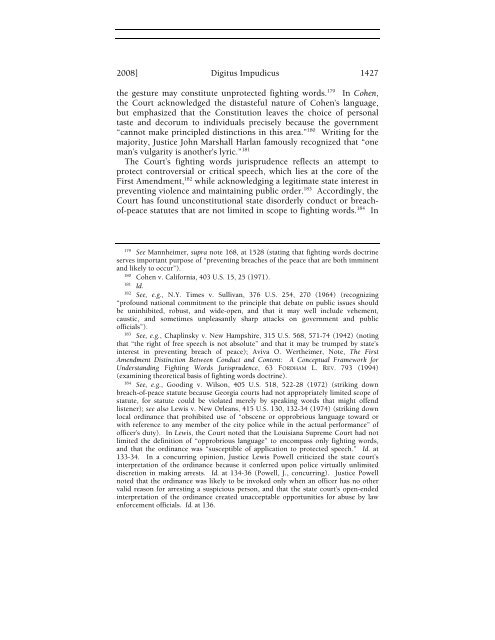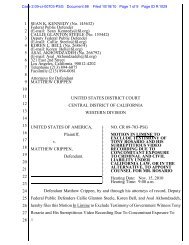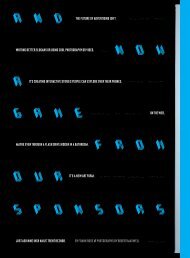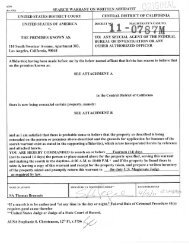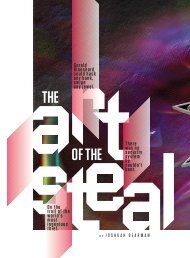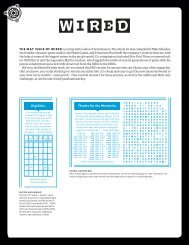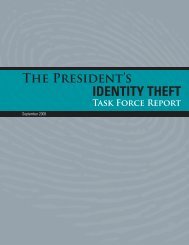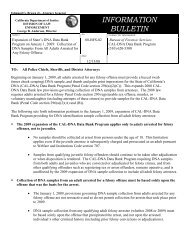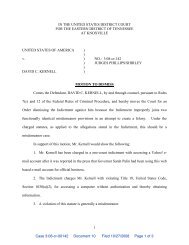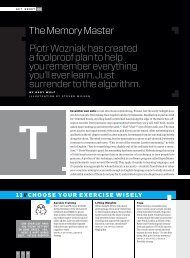Digitus Impudicus: The Middle Finger and the Law - Wired
Digitus Impudicus: The Middle Finger and the Law - Wired
Digitus Impudicus: The Middle Finger and the Law - Wired
Create successful ePaper yourself
Turn your PDF publications into a flip-book with our unique Google optimized e-Paper software.
2008] <strong>Digitus</strong> <strong>Impudicus</strong> 1427<br />
<strong>the</strong> gesture may constitute unprotected fighting words. 179 In Cohen,<br />
<strong>the</strong> Court acknowledged <strong>the</strong> distasteful nature of Cohen’s language,<br />
but emphasized that <strong>the</strong> Constitution leaves <strong>the</strong> choice of personal<br />
taste <strong>and</strong> decorum to individuals precisely because <strong>the</strong> government<br />
“cannot make principled distinctions in this area.” 180 Writing for <strong>the</strong><br />
majority, Justice John Marshall Harlan famously recognized that “one<br />
man’s vulgarity is ano<strong>the</strong>r’s lyric.” 181<br />
<strong>The</strong> Court’s fighting words jurisprudence reflects an attempt to<br />
protect controversial or critical speech, which lies at <strong>the</strong> core of <strong>the</strong><br />
First Amendment, 182 while acknowledging a legitimate state interest in<br />
preventing violence <strong>and</strong> maintaining public order. 183 Accordingly, <strong>the</strong><br />
Court has found unconstitutional state disorderly conduct or breachof-peace<br />
statutes that are not limited in scope to fighting words. 184 In<br />
179 See Mannheimer, supra note 168, at 1528 (stating that fighting words doctrine<br />
serves important purpose of “preventing breaches of <strong>the</strong> peace that are both imminent<br />
<strong>and</strong> likely to occur”).<br />
180 Cohen v. California, 403 U.S. 15, 25 (1971).<br />
181 Id.<br />
182 See, e.g., N.Y. Times v. Sullivan, 376 U.S. 254, 270 (1964) (recognizing<br />
“profound national commitment to <strong>the</strong> principle that debate on public issues should<br />
be uninhibited, robust, <strong>and</strong> wide-open, <strong>and</strong> that it may well include vehement,<br />
caustic, <strong>and</strong> sometimes unpleasantly sharp attacks on government <strong>and</strong> public<br />
officials”).<br />
183 See, e.g., Chaplinsky v. New Hampshire, 315 U.S. 568, 571-74 (1942) (noting<br />
that “<strong>the</strong> right of free speech is not absolute” <strong>and</strong> that it may be trumped by state’s<br />
interest in preventing breach of peace); Aviva O. Wer<strong>the</strong>imer, Note, <strong>The</strong> First<br />
Amendment Distinction Between Conduct <strong>and</strong> Content: A Conceptual Framework for<br />
Underst<strong>and</strong>ing Fighting Words Jurisprudence, 63 FORDHAM L. REV. 793 (1994)<br />
(examining <strong>the</strong>oretical basis of fighting words doctrine).<br />
184 See, e.g., Gooding v. Wilson, 405 U.S. 518, 522-28 (1972) (striking down<br />
breach-of-peace statute because Georgia courts had not appropriately limited scope of<br />
statute, for statute could be violated merely by speaking words that might offend<br />
listener); see also Lewis v. New Orleans, 415 U.S. 130, 132-34 (1974) (striking down<br />
local ordinance that prohibited use of “obscene or opprobrious language toward or<br />
with reference to any member of <strong>the</strong> city police while in <strong>the</strong> actual performance” of<br />
officer’s duty). In Lewis, <strong>the</strong> Court noted that <strong>the</strong> Louisiana Supreme Court had not<br />
limited <strong>the</strong> definition of “opprobrious language” to encompass only fighting words,<br />
<strong>and</strong> that <strong>the</strong> ordinance was “susceptible of application to protected speech.” Id. at<br />
133-34. In a concurring opinion, Justice Lewis Powell criticized <strong>the</strong> state court’s<br />
interpretation of <strong>the</strong> ordinance because it conferred upon police virtually unlimited<br />
discretion in making arrests. Id. at 134-36 (Powell, J., concurring). Justice Powell<br />
noted that <strong>the</strong> ordinance was likely to be invoked only when an officer has no o<strong>the</strong>r<br />
valid reason for arresting a suspicious person, <strong>and</strong> that <strong>the</strong> state court’s open-ended<br />
interpretation of <strong>the</strong> ordinance created unacceptable opportunities for abuse by law<br />
enforcement officials. Id. at 136.


